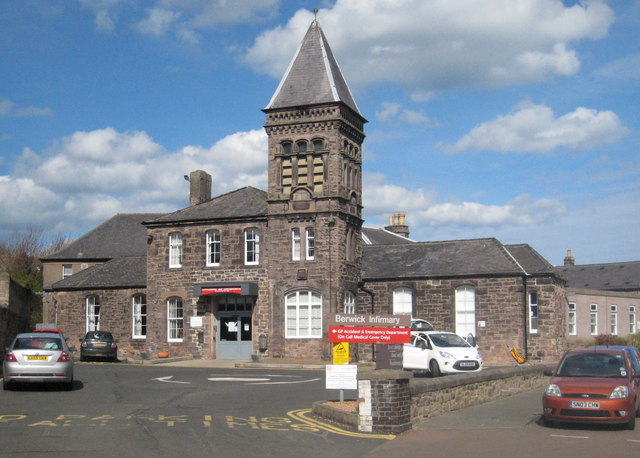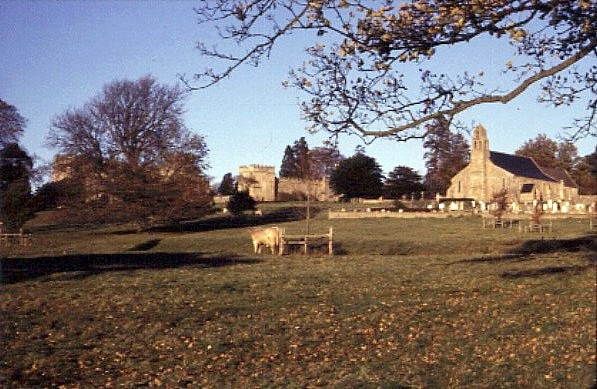
FORD WAR MEMORIAL
IMPRESSIVE DEDICATION SERVICE
The old grey stone church at Ford, with its appearance of serene antiquity, must, in past associations with the historic castle, have witnessed many a solemn scene through the long centuries, but surely none so solemn as that on Sunday evening last, when the magnificent war memorial to the sons of the parish who fell in the Great War was unveiled and dedicated. Nineteen made the supreme sacrifice, a son of the Castle, as well as lads from the farms and villages, and on Sunday the relatives and friends of the men met to commemorate their loved ones, and in doing so to draw inspiration from their heroic example.

It was a glorious summer evening, and in the brilliant sunshine from far and near, came motorists, cyclists, and those afoot, in such numbers that seating accommodation was quite insufficient, and many had to stand at the back of the church and in the entrance porch, throughout the service. As the waiting crowd filed slowly into the church, there floated through the building the soft tones of the Largo Appassionata movement, with its solemn staccato accompaniment from Beethoven’s second Sonata, played on the fine organ by Mr. J. H. Binks. Seats were reserved for the relatives, and the pews in the south aisle, neath the memorial were occupied most fittingly by the Comrades of the dead heroes who were fortunate enough to return from the war, and who paraded under Comrade T. Henry, Crookham. The beautiful service, specially drafted for the occasion, was conducted by Bishop Neligan, Rector of Ford, printed copies having being distributed amongst those present. The lessons were read by Lord Joicey, Ford Castle, and the sermon preached by Professor Albert A. Cock, University College, Southampton, who took the place of Bishop Welldon, Dean of Durham, who was unable to fulfil his promise to assist.
LOCAL NEWS
Capt. Alfred Goodson, who is to marry Miss Joan Leyland, is a Yeomanry officer, and is the eldest son of Sir Alfred and Lady Goodson, of Waddeton Court, Brixham, as well as Kilham, Mindrum. Sir Alfred Goodson, who was knighted in 1915, says the “Daily Mail,” a Manchester and London merchant and manufacturer, and a director of Goodsons, Ltd. He was at one time with Messrs Hitchcock, Williams and Co., of St Paul’s churchyard, and afterwards started business in the mantle trade., building up a huge business. A member of the Council of the National Pony Society, he is specially interested in horse breeding and agriculture, and has taken many prises with his hackneys, including the hackney championship. He owns a great deal of property in the Knutsford district of Cheshire. Captain Graham Leventhorpe, D.S.O., of the Royal Field Artillery, who is to marry Mrs Geoffrey Lambton, Mr and Mrs Leyland’s other daughter, is a fine cricketer. Mrs Lambton was first married in June 1914, and her husband was killed at the front early in September of the same year. Their daughter, Monica, was born after his death.
Visitors on the Magdalene Fields Golf Course on Monday evening were greatly interested in witnessing a match between two ex-soldiers who had both lost an arm in the war. One was minus the right arm and the other had had his left arm taken off at the shoulder. Both men drove and approached the greens much better than several of the most experienced players of the club could do, and they very seldom pulled a ball into the rough. A Berwick golfer, asked for his opinion on the men’s play, remarked he would not like to be giving a small handicap to either of them. The peculiarity of the play of the man who lost his right arm, was that he played right handed with his wrist in front of the club. Though his stroke was more of the nature of a “pull” than a “drive,” he got marvellous results.
NEW BRIDGE AT BERWICK STATION
THE WORK COMMENCED
Operations have been started by the North British Railway in the preliminary work connected with the erection of a new bridge carrying the Great North Road over the railway at Berwick Station. A large number of workmen are now engaged shifting the tracks of water and gas mains and preparing the foundation for supporting the piers.

The new bridge which, it is understood, will be constructed of steal, will provide a sweeping approach to the North Road—an improvement which will be greatly appreciated by motorists. It will be so constructed as to fit in with plans for the new station which the Company proposes to build when labour and material are more easily procured.
A portion of the parapet of the old stone bridge has been removed, and as work on the construction of the temporary bridge progresses other portions of walling will be taken down. The work is attended with some difficulty as the continuous run of traffic north and south cannot be held up. Workmen digging foundations and shifting the water mains are frequently stopped until the lines are clear. Telephone and telegraph wires are also being reconnected to new poles.
The present stone bridge, which is in a tumble down state, dates back to the time when the station was built. Originally the road from the town led down by the bank to the coal and implement dock and up the sunken road between the present stone bridge and Tommy the Miller’s field. The original stone of the retaining wall of this portion of the great north road is still visible from Tommy the Miller’s.
In those days the top of Castlegate was much different to what it is now. The river side of Tweed Street and a part of the landward side were grassy banks known as the Windmill Hole. It was no easy way of finding one’s way into the town in the dark and one such case occurred where a gentleman riding into the town on horseback fell over the banks at Windmill Hole and was seriously injured.
When the new Station at Berwick does come—it has been promised so long that some fear it will never materialise—considerable alteration will be made in the “lies” and ground near the old castle. If excavations go on, antiquarians may find some interesting remains of olden days unearthed, as hereabouts the network of underground passages and chambers have never fully been traced.
NOTES FROM SPITTAL
The Admiralty Certificate of honourable mention in dispatches has been awarded to James Patterson, for having sighted an enemy submarine and assisted in its destruction while serving on one of H.M. mine sweepers. The certificate was handed over by Lieut.-Commander James Toohey at the Customs House on Monday.
Once more the lifeboat has come back to Spittal, and now rests on the sands below Sandstell Road. It is the intention of the lifeboatmen to erect a temporary shed over the boat and carriage to save it from the weather, and also from the attentions of the children, who in their curiosity have been climbing about it and doing minor damage.

The permanent house for the new motor lifeboat has not yet been started, but we believe it will be erected near the east side of the ferry landing on the high ground. A trolley line is proposed to be laid below the lifeboat house leading down to low water mark, and the motor boat will be lowered from the house by electrically driven winches and davits, with its carriage on to the trolley lines when launching. Though the full particulars of the proposed lifeboat house are not available, it may be taken that it will be thoroughly up to date and fitted with the latest time and labour-saving devices.
An open race was to have been flown from Alnmouth on Saturday, but owing to the heavy rain the birds were returned by rail, the weather being so bad for liberation. The race will be flown on Saturday first. The club programme will be concluded on Saturday, when the Nottingham Y.B. race will be flown. The birds will be liberated at 9.45 a.m., ringing today (Friday) 2 p.m. The Vice-President (Mr Morton Boston) has kindly given the first prize.




